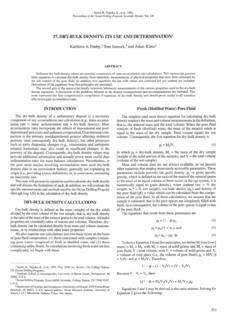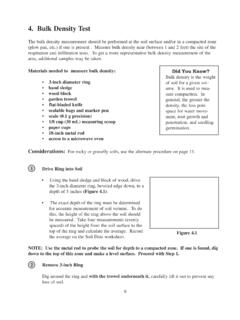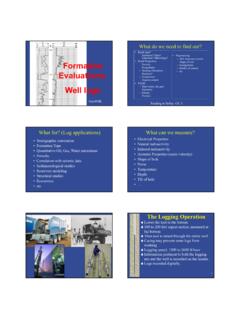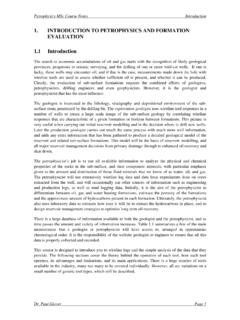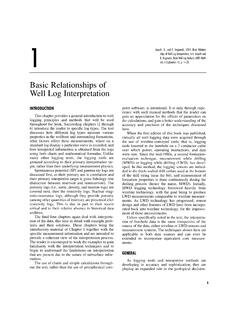Transcription of Inherent Factors Affecting Bulk Density and Available ...
1 Page 1 Guides for Educators bulk Density is an indicator of soil compaction and soil health. It affects infiltration, rooting depth/restrictions, Available water capacity, soil porosity , plant nutrient availability, and soil microorganism activity, which influence key soil processes and productivity. It is the weight of dry soil per unit of volume typically expressed in grams/cm3. Total volume of surface soil is about 50% solids, mostly soil particles (45%), and organic matter (generally < 5%); and about 50% pore space which are filled with air or water (Figure 1).
2 When determining bulk Density , the amount of soil moisture must be determined. Available water capacity is the amount of soil moisture Available to plants, varies by texture (Figure 2), and is reduced when compaction occurs. bulk Density can be managed, using measures that limit compaction and build soil organic matter. Figure 1. Four major components of soil volume (Michigan Field Crop Ecology, 1998, E-2646, p. 13). Figure 2. Relationship between Available water and texture (Ohio Agronomy Guide, 14th Ed.)
3 Bull. 472-05). Inherent Factors Affecting bulk Density and Available Water Capacity Inherent Factors that affect bulk Density such as soil texture cannot be changed. bulk Density is dependent on soil organic matter, soil texture, the Density of soil mineral (sand, silt, and clay) and their packing arrangement. As a rule of thumb, most rocks have a Density of g/cm3 so ideally, a silt loam soil has 50% pore space and a bulk Density of g/cm3. Generally, loose, well-aggregated, porous soils and those rich in organic matter have lower bulk Density .
4 Sandy soils have relatively high bulk Density since total pore space in sands is less than sil t or clay soils. bulk Density typically increases with soil depth since subsurface layers are more compacted and have less organic matter, less aggregation, and less root penetration compared to surface layers, therefore contain less pore space. Available water capacity (Figure 2) is affected by soil texture, presence and abundance of rock fragments, soil depth and restrictive layers.
5 Page 2 Guides for Educators Soil bulk Density / Moisture / Aeration Soil Quality Kit USDA-NRCS bulk Density ManagementBulk Density can be changed by management practices that affect soil cover, organic matter, soil structure, compaction, and porosity . Excessive tillage destroys soil organic matter and weakens the natural stability of soil aggregates making them susceptible to erosion caused by water and wind. When eroded soil particles fill pore space, porosity is reduced and bulk Density increases.
6 Tillage and equipment travel results in compacted soil layers with increased bulk Density , most notably a plow pan (Figures 3 and 4). Tillage prior to planting temporarily decreases bulk Density on the surface but increases at the depth of tillage. Subsequent trips across the field by farm equipment, rainfall events, animals, and other disturbance activities will also compact soil. Long-term solutions to soil compaction center on decreasing soil disturbance and increasing soil organic matter.
7 A soil s Available water capacity is also affected by organic matter and compaction. Organic matter increases a soil s ability to hold water, both directly and indirectly. Compaction increases bulk Density and reduces total pore volume, consequently reducing Available water holding capacity. The following measures increase organic matter, and reduce compaction, which improve bulk Density and porosity : Practices that increase organic matter such as continuous no-till, cover crops, solid manure or compost application, diverse rotations with high residue crops and perennial legumes or grass used in rotation; Minimize soil disturbance and avoid operating equipment when soils are wet; Use designated roads or rows for equipment.
8 Reduce the number of trips across a field; Subsoil to disrupt existing compacted layers; and Use multi-crop systems involving plants with different rooting depths to help break up compacted soil layers. Figure 3. Compacted soil in wheel traffic row. Figure 4. Compacted plow layer inhibiting root penetration and water movement through soil profile (adapted from: The Nature and Properties of Soils, 10th Edition). Compacted inter-row restricts roots, worms, aeration, and N availability.
9 Page 3 Guides for Educators Soil bulk Density / Moisture / Aeration Soil Quality Kit USDA-NRCS Water-Filled Pore Space and porosity When determining bulk Density , water-filled pore space and porosity can also be calculated. When water-filled pore space exceeds 60%, several important soil processes are impacted. Soil respiration and nitrogen cycling (ammonification and nitrification) increase with increasing soil moisture (Figure 5). Lack of aeration also interferes with a soil organism s ability to respire and cycle nitrogen.
10 In dry soils, these processes decline because of lack of soil moisture. As soil water-filled pore space exceeds 80%, soil respiration declines to a minimum level and denitrification occurs resulting in loss of nitrogen as gas, emission of potent greenhouse gases, yield reduction, and/or increased N fertilizer expense. Figure 5. Relationship of water-filled pore space to soil microbial activity (Linn and Doran, 1984). Soil bulk Density Problems and Relationship to Soil FunctionHigh bulk Density is an indicator of low soil porosity and soil compaction.











